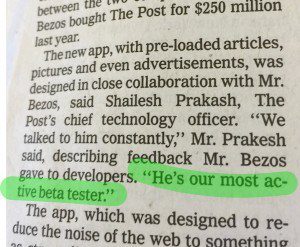Perhaps they are (or were) geeks, but I believe Steve Jobs and Jeff Bezos’ obsession with being the biggest beta user of new products defined their success and is something of which all top executives — almost no matter the business — should take note. In a recent NYT article, speaking of the new direction of The Washington Post, now owned by Jeff Bezos, the Post’s CTO says of Bezos:
[Jeff]’s our most active beta tester.”
Naturally, both Bezos and Jobs are/were part of a technology company, but at the end of the day, the items they are using and the experiences they are creating are impacting consumers of all products around the world. Thus, all manner of company need to pay heed the customer and user experiences their companies (Apple and Amazon) are creating.
As the topic of “customer centricity” comes of age, it is landing in annual reports, surfacing in strategy reports and board rooms around the world. Yet, arguably the biggest stumbling block is the leadership itself. The big question is: does the top brass demonstrate and embody customer centric leadership?
Customer Centric Leadership
But, what does customer centric leadership look like? First, it’s a mindset. Secondly, there are behaviors that make it come alive. {Tweet this!} The mindset requires systematically keeping the customer in the conversation. Bezos has the now-famed “empty chair” in Amazon executive meetings to represent the voice of the customer. Other companies may be tempted to try this concept out; but, if the idea didn’t come from the boss, I highly doubt that it will be successful. The chair must be given the authority to speak. It must have a place, even when there are not enough chairs for people to sit in… And that takes a tenacity that needs to be owned by the leader. {Tweet this!} Otherwise, it will inevitably be thrown out as a gimmick.
Digital and Customer Centricity
 As companies drive their digital agenda, the greater the realization that being customer centric is critical. Digital devices and platforms have created many more opportunities for customers to interact directly with staff, too often exposing companies whose entire fabric may not be truly customer centric. That a CEO may not always be the incarnation of 100% customer centric leadership, I can accept (different profiles, roles, etc.). However, if the CEO and her/his leadership team do not, as a whole, live and prove their “customer centric mindset,” the efforts will fall on deaf ears (i.e. the customers). {Tweet this!} In the instances of Jeff Bezos, Steve Jobs and even Richard Branson, they are each the founder and embodiment of the corporate culture. Their passion and ownership of the brand experience has defined their success. They are/were entrepreneurs at the head of massive organizations. Of course, they have weaknesses and foibles with which to deal. But, they embody a leadership style that cascades down. For a “corporate” CEO, these are difficult (if not impossible) shoes to fill, especially when faced with the unyielding pressures of short-term results.
As companies drive their digital agenda, the greater the realization that being customer centric is critical. Digital devices and platforms have created many more opportunities for customers to interact directly with staff, too often exposing companies whose entire fabric may not be truly customer centric. That a CEO may not always be the incarnation of 100% customer centric leadership, I can accept (different profiles, roles, etc.). However, if the CEO and her/his leadership team do not, as a whole, live and prove their “customer centric mindset,” the efforts will fall on deaf ears (i.e. the customers). {Tweet this!} In the instances of Jeff Bezos, Steve Jobs and even Richard Branson, they are each the founder and embodiment of the corporate culture. Their passion and ownership of the brand experience has defined their success. They are/were entrepreneurs at the head of massive organizations. Of course, they have weaknesses and foibles with which to deal. But, they embody a leadership style that cascades down. For a “corporate” CEO, these are difficult (if not impossible) shoes to fill, especially when faced with the unyielding pressures of short-term results.
Customer centric behavior
In terms of visible behaviors, in this digitally enhanced world, the willingness and ability of the leadership team to gauge a great user experience is a fundamental customer centric skillset.
Leaders must consider beta testing a part of their responsibilities. {Tweet this!}
Understanding the quality of great user experience is a strategic issue, even more so with the rise of mobile. The real challenge is that it is an evolving space. What is a great user experience today will quickly become outdated and surpassed. While becoming a geek is not what I am advising all CEOs to do, I emphatically believe that CEOs must get familiar with the user experience personally. Ideally, the CEO is among the first to try out new applications, capable of detecting the difference between a bad UX and a bug, knowing what are the new techniques and environments that make for a more attractive experience. While having the customer centric mindset does not come overnight and is, in all likelihood, not possible for many current CEOs who have become ‘too set in their ways,’ top executives (not just the CMO) must learn to become obsessed with the digital user experience (including web surfing, apps, devices and, even, games…) in order to make the appropriate strategic decisions about digital-related activities. {Tweet this!}
Your thoughts are welcome!











